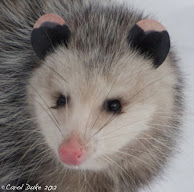American Robins are members of the Thrush family and are particularly fond of the Crabapple Orchard. They are often thought to be heralds of spring but here they reside all year round, certainly in part due to this little orchard. Robins live on fruit in the winter months and are seen during the growing seasons standing like sentinels one minute and the next running nearly horizontal to the ground searching for worms and insects. They are scattered in open areas throughout the gardens . . . sometimes in groups of fifty or more spaced a few feet apart making the land appear to be in motion.
Come spring theirs will be the first song to fill the gardens and they will begin nesting earlier than other birds. Robins can raise up to three broods a year, though less than half of their babies will survive to become adults. They are preyed upon by Hawks, Crows, Bluejays, snakes, weasels and squirrels to name a few. Enough do survive, for I have read that some winter roosts can be as large as a quarter million!
Robins will also dine on the smaller rose hips in the garden . . . favored as well by the Bluebirds. The Northern Cardinals prefer the larger Rosa Rugosa hips, which are in abundance just across from this Crabapple . . . the very direction the female Cardinal is facing. The Cardinals do not appear to eat the Crabapples and I believe that is why there is no contest here between the two birds.
A female Cardinal works hard to open the outer covering of the hips.
She appears to be examining this one carefully . . .
clearly it passes the test!
When we hear the songs of birds, we might assume that only the males are singing and in most cases this is true. The female Cardinal . . . along with a few other female songbirds . . . also sings and her song can be more varied and last longer than the males. I have read that the more rose hips a Cardinal eats the redder their color becomes. I think it rather terrific that not only can my garden feed the birds but it may help to paint them as well!
This male surely has been eating tons of rose hips!
The couple is very conscientious and leave nothing to waste on the cold snowy garden floor.
It must be pretty cold as this fellow shows . . . all puffed-up and holding one foot within the warm fluffy feathers.
Now . . . where was I?
There were two large shrubs filled with hips in 2009. This last summer due to the drought the roses did not produce as many rose hips . . . still there are a good many for the Cardinals to feed on complementing their diet of wild grapes . . . dried at this time of year. . . sumac and many varieties of seeds.
Both the male and female will defend their territory from other Cardinals. It is very comical to see them relentlessly tapping their reflections in windows or even car rear-view mirrors during the season they are rearing their young.
One day last winter a Robin was equally resolute in driving away the Bluebirds from the tiny rose hips behind the farmhouse. I am not certain of the identification of this wild rose but it may be the invasive Japanese multiflora . . . though the hips seem more oval in shape. The Bluebirds love the smaller size and enjoy dining on the fruits of the two bushes I inherited. The Robins will have none of it, however, and even when the flock is off somewhere else feeding, one will remain behind to watch over the nutritious hip filled rose bushes.
The Bluebirds are always on the fly and I feel I must have a word with the Robin!
He does not appreciate my scolding . . . is not interested in sharing . . . but does finally fly off allowing the Bluebirds to feast.
I have promised myself to find out exactly which rose this is and to replace it with a native rose that will provide similar hips. I will leave these until the new ones become established. Please let me know if you think you can identify this plant. It has lovely small white clustered flowers. I cannot bear to remove a plant that offers such important winter food for birds.
Eastern North American Rhus glabra or smooth Sumac if very invasive but does have some redeeming graces. It has vibrant fall colors and more importantly provides berries rich in vitamin C that many birds love and which sustains them throughout the cold winter months.
This morning Bluebirds are flying up to the barn windows and doors, as I cast out new born flies! Finally I find a beneficial purpose for those born inside during the winter. I am happy to report that I am seeing many Bluebirds today. In fact it is very busy out with Juncos, Cedar Waxwings, Bluebirds, Robins, Chickadees, Cardinals and surprisingly a few Pine Siskins darting about the naked trees and shrubs.
My next post will feature other plants and trees about the gardens that also feed the birds.













































































































































